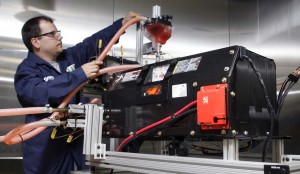The consolidation in the business of making lithium-ion batteries, a key component in electric vehicles, is moving faster than expected – the recent bankruptcy and sale of A123’s automotive operations to JCI just the latest example.
The consulting firm of Roland Berger predicted a consolidation back in 2010. But in an update to the report issued this week, it is saying the shake-out is unfolding faster than expected and predicts only six to eight international players in lithium battery production will remain in the market by 2017.
The move could head off a potentially devastating price war among competitors at a time of unexpectedly slow sales of battery-based vehicles. But for auto manufacturers, that could translate into higher component costs that, in turn, slow the growth in demand for electrified vehicles, some analysts warn.
The main drivers of consolidation: include overcapacity, fierce price competition, slow market growth, low margins and high R&D investment needs. Over the last two years, the industry has seen a number of new players filing for bankruptcy.
“The tremendous hype around Li-Ion batteries has left us with a bubble,” explains Thomas F. Wendt, Partner at Roland Berger Strategy Consultants’ Chicago office. “Government support and far too optimistic growth assumptions about electro mobility have led to major overcapacities. What is more, the ambitious drive to achieve economies of scale as fast as possible has triggered a fierce price war between the established market players in Asia and new players in the US.”
The Roland Berger study starts with a careful, bottom-up calculation of cell and material costs right along the value chain. It demonstrates that, in many cases, producers of large-formal lithium batteries will not be able to generate sufficient earnings to cover their costs of capital. This is because the automotive OEMs have been able to force significantly lower prices on their battery suppliers. OEMs will be paying between EUR 180 and 200 per kilowatt hour for large-format battery cells until 2014/2015 according to the report.
“In this environment, battery producers can’t generate sufficient cashflow to make vital investments in new and more efficient production systems and in the R&D needed for next-generation batteries. Yet this spending is important for driving down material costs,” says Wendt.
The tight margins and lack of capital for new investment will result in a major market shake-out over the next few years. Only a few of the big suppliers of LIon batteries will survive, with players from Korea and Japan probably among them.
In this struggle for survival, both the battery manufacturers and their customers, the OEMs, will be forced to rethink their strategies. Alternative technologies, like start-stop systems or light-hybrid engines, do not offer a promising market for battery makers. New developments in alternative technologies – including seemingly old-fashioned lead-acid batteries — also present some big challenges for suppliers of lithium batteries as they seek to remain competitive.
“On the other side, the OEMs have to review their supplier portfolio and find the most innovative companies to collaborate with. This is essential for securing innovative solutions and significant cost advantages,” concludes Wendt.

